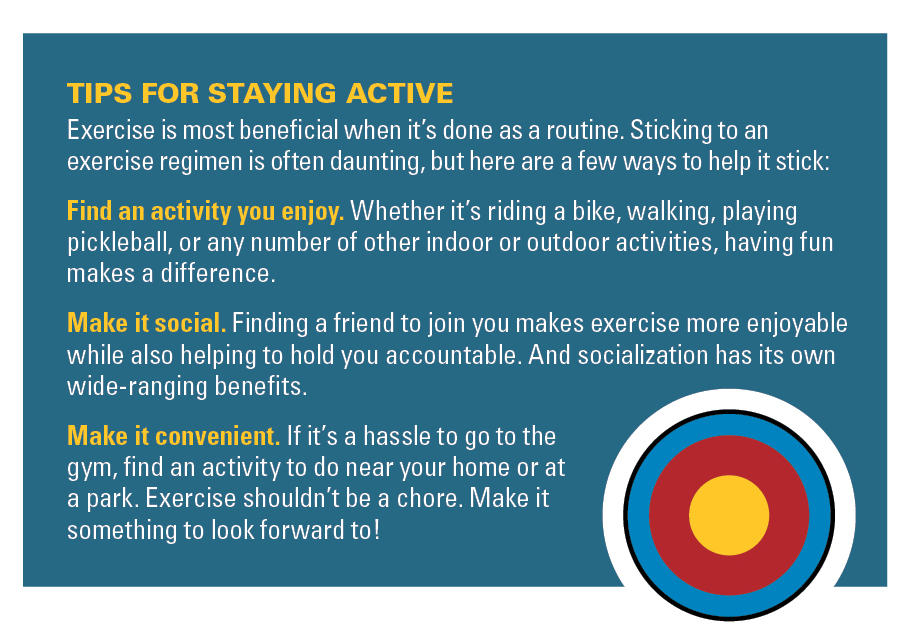You’d never know it from watching her on the archery range, but Edna Siniff has faced more than her fair share of medical challenges.
The 83-year-old Mahtomedi resident has managed Type 2 diabetes for the last decade, a benign tumor in her inner ear sometimes makes balance difficult, she’s had both knees replaced , and a tendon in her left foot was removed. But none of that stopped her from shattering the archery record in her age group at the 2019 National Senior Games in New Mexico—just the latest on a long list of archery achievements.
Archery is just Siniff’s latest pastime— one she became serious about seven years ago after taking her two grandsons to a local range. Her life story includes traveling throughout the country, riding horses alongside bull wrestlers, building a straw-bale home that she lived in for years, farming, launching and running a community newspaper, and many other chapters.
The common theme, regardless of Siniff’s age: staying active. It’s a way of life she committed to as a child after watching sedentary seniors in her community succumb to health problems prematurely.
“So this is the thing that I told myself by the time I was nine—you don’t retire,” Siniff says. “And I don’t mean retire in the sense of a job. You don’t stop doing things, because when you stop doing things, you decay. And so that’s the little drum that’s kept ringing in my head all my life.”
A HEALTHY MINDSET
Adopting Siniff’s mindset could help many older adults live healthier lives, says Dr. Elizabeth Eckstrom, professor and chief of geriatrics at Oregon Health and Science University.
“There’s really good research showing that various types of activity can prevent or help manage chronic illnesses,” Eckstrom says.
In the U.S., six in 10 adults have a chronic disease and four in 10 have two or more. Though some risk factors, such as genetics, are unavoidable, many risks are related to lifestyle choices. A sedentary lifestyle puts adults at greater risk for a wide range of diseases, including cardiovascular conditions and cancer. Regular exercise can lower that risk and has also been shown to boost brain health and ward off dementia, Eckstrom says.
And for anyone already living with a chronic condition, increased activity can help manage it and reduce symptoms.
Chronic pain is one example of a condition that can be significantly improved through exercise, Eckstrom says.
“It’s never too late,” She says. “Exercise improves most chronic health conditions no matter how bad it is already.”
Taking up a specific sport or activity, as Siniff did with archery, is a good way to make exercise a habit. But regardless of what you do to stay active, Eckstrom suggests three focus areas:
AEROBIC EXERCISE
Eckstrom recommends getting 30 minutes of aerobic exercise each day. That can mean brisk walking, cycling, swimming, playing pickleball, or taking part in any number of other endurance exercises. Find an activity you enjoy doing and, if possible, a partner to join you. Involving a friend can help make daily exercise fun and hold you accountable.
The Centers for Disease Control and Prevention (CDC) recommends doing aerobic exercise at a moderate or vigorous intensity. The CDC suggests using a 10-point scale to determine your level of intensity—sitting is zero and working as hard as you can is 10. Moderate activity is a five or six, vigorous is a seven or eight.
Fitness levels vary from person to person. Walking briskly might be moderate exercise for one individual and vigorous for another, for example. Done properly, aerobic exercise will get you breathing harder and your heart beating faster. Just remember not to push your limits. Do what you feel is comfortable and right for your abilities.
STRENGTH TRAINING
Resistance exercises, such as lifting weights or working with resistance bands, should be done three times a week, again in 30-minute sessions. Resistance training is important for strengthening muscles and bones, preventing muscle loss known as sarcopenia, or bone degradation that can lead to osteoporosis.
“And interestingly, even people in their 90s who are weak and frail, if they begin strength training, they can reverse sarcopenia,” Eckstrom says.
Regular strength training has also been shown to improve brain function, she says.
The CDC recommends trying eight to 10 repetitions for each strength training activity, which counts as one set. Try to do one-to-three sets. You should do them to the point where it’s hard to complete another repetition without assistance, the CDC says.
Keep in mind that some hobbies or household activities might double as strength training—heavy gardening that involves digging, for instance.
BALANCE
Eckstrom also recommends doing balance exercises three times a week at 30-minute intervals. She suggests alternating days for balance and resistance activities, so you don’t try to do too much in a single day.
Balance activities can include dance, yoga, or Eckstrom’s favorite—tai chi. These activities can help improve reaction time, coordination, and brain function, and help prevent falls. If balance or walking long distances is challenging for you, you might give walking poles a try. Siniff uses walking poles to help get around, and it turns out they have several benefits beyond keeping her upright.
According to the Mayo Clinic, walking poles work your arms, shoulders, chest and upper back as you walk. The poles, which usually have rubber tips and straps on the handles, add intensity to your walks, help to maintain posture and strengthen back muscles, and take the load off your back, hips and knees. Mayo Clinic suggests walking poles might even improve your mood.
KEEPING A PROMISE
Siniff is determined to keep the promise she made to herself as a little girl—to stay active regardless of her age.
“Archery allows me to get out and do things in a different way,” Siniff says. “I can’t ride horses anymore, I can’t bowl anymore, or swing a baseball bat. But I can do this.”
Siniff learned to shoot as a teenager, but didn’t pick up a bow again until the range visit with her grandsons. After impressing her grandsons and the range staff with consistent bullseyes using a half-a-century-old bow, she decided to stick with the sport and compete in it. She earned a gold medal at the Senior Games in 2015, before breaking the women’s record for compound release bow in her age group, earning 1,457 points out of a possible 1,800.
The sport has tested her stamina in all sorts of conditions. She’s competitive, but she also knows her limits, and is careful not to pull more weight than she can handle—25 pounds with every draw.
Siniff shoots at least once a week, inside during the winter months, firing a total of 60 arrows, usually from 20 yards out. In competition, she shoots from distances of up to 60 yards. She stands against a tall stool to help her balance and follows the same routine for each shot: taking a deep breath, eyeing the target, drawing the arrow back to her right cheek, and releasing. More often than not, the arrows sail straight to the bullseye.
“When I fire the first few arrows, I think to myself, how am I going to make it through 60 today? You know, because I’ll feel a little stiff,” Siniff says. “But by the time I’ve shot 10 or 20, my muscles are relaxed and it’s easier to pull.”
She will shoot five arrows, then walk to retrieve them before shooting another five, so she’s getting in many steps between rounds. She also does a lot of interacting with others and has made many friendships through the activity.
“Sixty arrows keeps me primed for competition,” Siniff says. “But it’s also the joy of sharing time with others while doing an exercise that is beneficial to your head, your heart, your limbs, and just getting out there and participating in life.”



